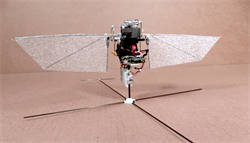 Research conducted in the Advanced Vertical Flight Laboratory (AVFL) at Texas A&M University was featured in the recent IEEE Spectrum online magazine.
Research conducted in the Advanced Vertical Flight Laboratory (AVFL) at Texas A&M University was featured in the recent IEEE Spectrum online magazine.
The project highlighted was the robotic hummingbird being developed by graduate student David Coleman and Moble Benedict, an assistant professor in the Department of Aerospace Engineering.
The hummingbird robot is capable of controlled, hovering flight, and does so via a custom-developed ultra-light autopilot with an on-board microprocessor and IMU. Employing a set of light-weight actuators, the vehicle is able to modulate the flapping wing kinematics in order to stabilize itself. This is the second hover-capable two-winged flapping-wing platform ever built; the other one being the DARPA funded Nano-Hummingbird developed by Aerovironment in 2011.
The project results have been presented at several regional and national level conferences with good peer reception. Research at the AVFL is focused on next-generation hover-capable UAVs, particularly small-scale cycloidal-rotor and flapping-wing based vehicles.
To read the article, visit the IEEE Spectrum website.